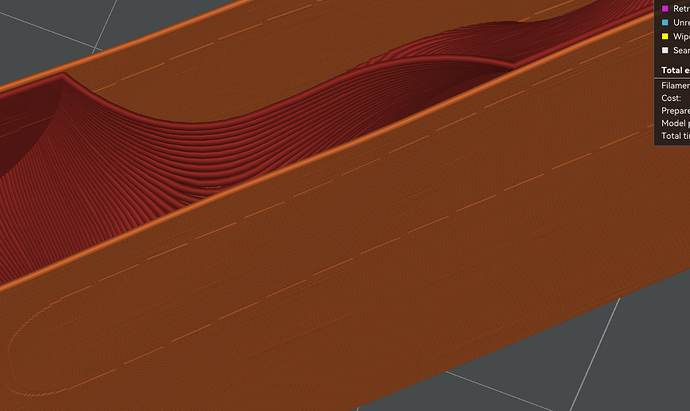Hi There.
I am working on settings for my ColorFab LW-PLA filament and while I feel that I am moving in the correct direction, I am having an issue with some shapes.
In particular, this is a mostly smoth surface that has some indentations. It is printed vertically. The indentantions are lines on the surface that are about 0.3mm deep and 0.6mm wide. These are intended to simulate “panel lines” in airplane surfaces.
The odd part is, as you can see in the image, some are printed as indentations but others are printed as protrusions. In some instances, an indentation that is meant to be a rectangle with round edges, is in fact an indentation and then it switches to a protrussion and then back to an indentation.
This is visible in the gcode, but I do not know what setting could be causing it. It seems to have something to do with the layers. The only other thing that the protrussions have in common is that they are all mostly horizontally aligned with the bed, if anything, they are only off horizontal by a few degrees.
Anyone knows what could be happening?
You still haven’t tuned for the filament optimally. The small features “protrude” because the pressure advance isn’t timed correctly, the extra “burst” of filament is coming too early or too late for the small feature and the plastic gets deposited in the wrong place.
Thanks, but pressure advance?
What setting is that?
The good news is, if you’re asking, you don’t know what it is, which means you haven’t tuned for it, so that makes it much more likely this is the issue. The printer does its own filament calibration, but that calibration has some “error” and may not be as good as a manual calibration. So you want to do a manual calibration.
As for what “Pressure Advance” is, and how to do these kinds of calibrations, there’s tons of information out there, this forum and the discord and FB forums. Just do some searching.
See the “Calibrations” tab in BBL Studio.
Well, I’ve been trying to do such calibration (both manual and automatic) since friday when I first tried this filament (which worked well on a previous 3D printer that I had). After about 15 different tries (@ around 20 minutes each) due to a vague “calibration error” message from the software, I finally got one “calibration process” to go through but the subsequent prints that I got out of the printer (8, if I am not mistaken) came out terrible.
That is why I am going now going through all settings that I can find and manually adjusting them and testing myself to see if I can get something decent to come out.
So, here is where I am at now, asking for help on this one particular thing that would make me happy enough with the printer.
I can imagine what “pressure advance” is, but I do not recall seeing this setting anywhere, however, I will check the “Calibrations” tab again as well the tons of information on FB and this forum.
Thank you
Yeah, I’m not surprised you had trouble with the automatic filament calibration. The Lidar sensor is susceptible to enough error, the calibrations aren’t always as good as they could be.
The manual calibration process cannot fail because it doesn’t rely on the printer to make any decisions. You run the cal, it prints a few different things, you look at them by eye and decide which is best. Then you manually input the settings for the filament and you turn off the printer’s auto calibration step.

